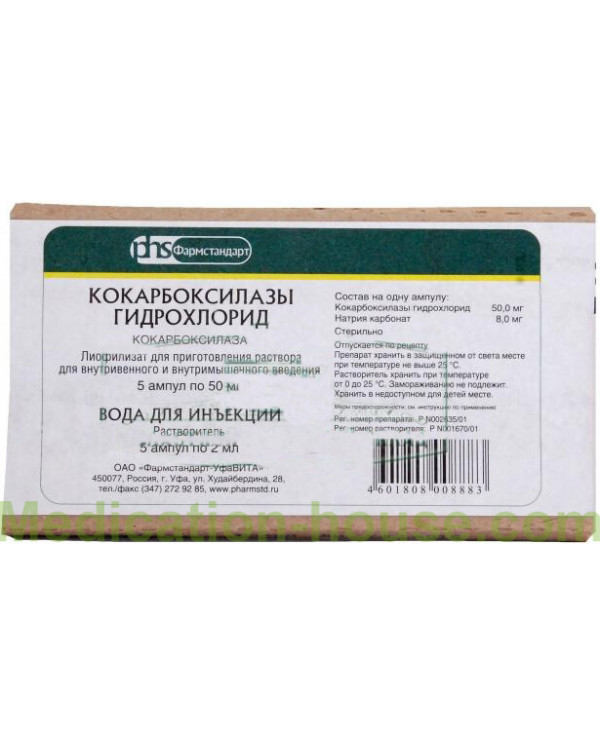Instruction for Cocarboxylase hydrochloride
You can buy Cocarboxylase hydrochloride here
Composition
1 bottle (ampoule) contains:
active ingredient - cocarboxylase hydrochloride 50 mg
excipient: sodium carbonate - 8.0 mg
Description
Porous mass of white color with a weak specific smell. Hygroscopic.
Pharmacotherapeutic group
Vitamin B1 and its combination with vitamins B6 and B12. Vitamin B1.
Pharmacokinetics
Cocarboxylase is rapidly absorbed after intramuscular administration. Penetrates into most tissues of the body. Metabolic decomposition. Degradation products are excreted primarily by the kidneys.
Pharmacodynamics
Cocarboxylase is an integral non-protein part (coenzyme) of enzymes that regulate metabolic processes. In the body is formed from thiamine due to its phosphorylation. It plays an especially important role in carbohydrate metabolism, in particular, in the oxidative decarboxylation of keto acids (pyruvic, α-ketoglutaric), as well as in the pentose phosphate pathway of glucose decomposition. It reduces the level of lactic and pyruvic acid in the body, improves glucose uptake, trophic nervous tissue, and helps normalize the function of the cardiovascular system.
Do not use cocarboxylase for the treatment of hypovitaminosis and avitaminosis B1, since its biological properties do not fully coincide with the properties of thiamine.
Indications for use
- complex therapy of hepatic and renal failure
- complex therapy of diabetic precoma and coma, diabetic ketoacidosis
- complex therapy of chronic heart failure and heart rhythm disorders
- peripheral neuritis
For children, the drug is prescribed for the same indications. In newborns, the drug is also used in the complex therapy of conditions associated with hypoxia and acidosis, including neonatal asphyxiation, hypoxic encephalopathy, circulatory failure, pneumonia, sepsis, etc.
Dosage and administration
Usually used as a component of complex therapy. Enter intramuscularly, at least - subcutaneously or intravenously. Before the introduction of the contents of the vial (ampoule) is dissolved in 2 ml of water for injection. For intravenous injection, the volume should be adjusted to 10–20 ml, with a droplet volume, to 200–400 ml by adding 0.9% sodium chloride solution or 5% glucose solution. The dose for administration is determined individually, taking into account the nature of the disease and the severity of the patient's condition. Adults are given 50–100 mg / day as a single dose. The course of treatment is 15-30 days. If necessary (diabetic coma), this dose can be re-administered after 1-2 hours. In the future, switch to maintenance therapy - 50 mg 1 time per day. In acute renal and / or liver failure, the drug is administered intravenously in a stream of 100-150 mg (4-6 ml) 3 times a day or drip (for 5% glucose solution) 100-150 mg (4-6 ml) for 1 -1.5 months.
Children are injected subcutaneously or intramuscularly: from birth to the third month of life - 25 mg 1 time per day; from 4 months to 7 years - 25-50 mg 1 time per day, 8-18 years old - 50-100 mg 1 time per day. If necessary, these daily doses can be administered in two doses.
Side effects
Rarely - allergic reactions (urticaria, skin rash, itching)
- intramuscular injection - hyperemia, itching, swelling at the injection site.
Contraindications
- individual hypersensitivity to the drug
- pregnancy and lactation period
Drug interactions
Cocarboxylase enhances the cardiotonic action of cardiac glycosides and improves their tolerability.
special instructions
It is necessary to consider the possibility of enhancing the cardiotonic action of cardiac glycosides when prescribing the dose of the latter. In case of flickering arrhythmia, the drug should not be administered intravenously.
The prepared solution should not be used with other drugs. Use the solvent enclosed in the package.
Use during pregnancy and lactation
The efficacy and safety of using Cocarboxylase hydrochloride for treating pregnant women or during breastfeeding have not been established, therefore, it is not recommended to prescribe the drug during this period.
Childhood
Used from birth. Do not use the drug intravenously.
Overdose
Symptoms: increased adverse reactions
Treatment: drug withdrawal. Symptomatic therapy aimed at normalizing respiration and cardiovascular activity.
Storage conditions
Store in original packaging to protect from exposure to light at a temperature not exceeding 25 ° C.
Keep out of the reach of children!
Shelf life - 3 years.
Do not use beyond the expiration date printed on the package.
Terms of sell
You don't need a prescription to buy Cocarboxylase hydrochloride.

